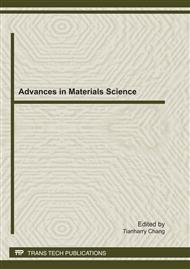p.49
p.53
p.57
p.61
p.66
p.72
p.76
p.81
p.85
A Microscopic Model of the Asymmetric Neck Growth during Sintering Process upon the Asymmetric Particle Arrangement
Abstract:
A kinetic Potts Monte Carlo model was used to investigate the microstructural evolution of a three particles configuration during sintering. The a series of peculiar phenomena was observed and analyzed quantitatively, which indicated that even if the particle shape and the contact area are both completely symmetrical, the asymmetric neck growth will arise due to a special particle arrangement. Although the linear relationship between neck size logarithm and time logarithm was consistent with the traditional theory, a slower neck growth rate comparing with that of the two sphere model displayed a result of the asymmetric neck growth. The analysis of the particle rotation was made to confirm the occurrence of the asymmetric neck growth. It was firstly observed that the morphology of the grain boundaries became bevel, and the reason for this morphology was discussed. All the special phenomena have proved that the asymmetric particle arrangement about the contact area can trigger the unstable neck growth.
Info:
Periodical:
Pages:
66-71
Citation:
Online since:
September 2011
Authors:
Price:
Сopyright:
© 2011 Trans Tech Publications Ltd. All Rights Reserved
Share:
Citation:


